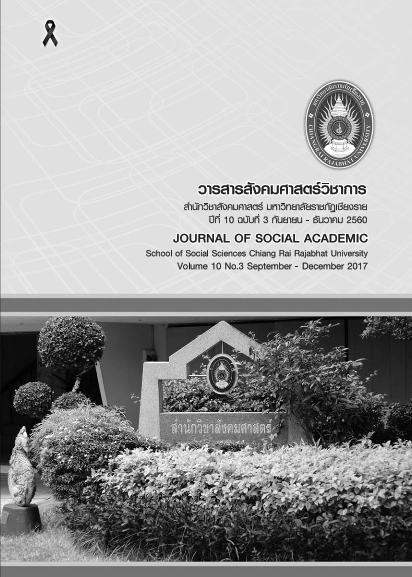การจัดการทรัพยากรมนุษย์และวัฒนธรรมองค์การเชิงสร้างสรรค์ที่มีต่อผล การดำเนินงานของวิสาหกิจส่งออกขนาดกลางและขนาดย่อม ในเขตภาคเหนือตอนบนของประเทศไทย
Main Article Content
บทคัดย่อ
การวิจัยนี้มีวัตถุประสงค์ (1) เพื่อศึกษาผลการดำเนินงานของผู้ประกอบการวิสาหกิจส่งออกขนาดกลางและขนาดย่อม(2) ศึกษาอิทธิพลของการจัดการทรัพยากรมนุษย์วัฒนธรรมองค์การเชิงสร้างสรรค์และภาวะผู้นำการเปลี่ยนแปลงที่มีต่อผลการดำเนินงานและ (3) ศึกษาผลการดำเนินงานขององค์การจำแนกตามประเภทของวิสาหกิจระยะเวลาการดำเนินงานและจังหวัดที่ดำเนินกิจการเป็นการวิจัยแบบผสมผสานประชากรคือผู้ประกอบการส่งออกจำนวน 268 คน คิดเป็นร้อยละ 66.50เครื่องมือวิจัยคือแบบสอบถามและแบบสัมภาษณ์เชิงลึกวิเคราะห์ด้วยสถิติพรรณนาและสถิติอนุมาน
ผลการวิจัยพบว่าผู้ประกอบการส่งออกมีความคิดเห็นต่อภาวะผู้นำการเปลี่ยนแปลงอยู่ในระดับค่อนข้างมากที่สุดรองลงมาคือการจัดการทรัพยากรมนุษย์วัฒนธรรมองค์การเชิงสร้างสรรค์และผลการดำเนินงานอยู่ในระดับมากจากการวิเคราะห์อิทธิพลเชิงโครงสร้างสรุปได้ว่าการจัดการทรัพยากรมนุษย์มีอิทธิพลทางตรงต่อวัฒนธรรมองค์การเชิงสร้างสรรค์มากที่สุดรองลงมาวัฒนธรรมองค์การเชิงสร้างสรรค์มีอิทธิพลทางตรงต่อภาวะผู้นำการเปลี่ยนแปลงและวัฒนธรรมองค์การเชิงสร้างสรรค์มีอิทธิพลทางตรงต่อการจัดการทรัพยากรมนุษย์
จากการค้นพบองค์ความรู้ใหม่พบว่าอิทธิพลของวัฒนธรรมองค์การเชิงสร้างสรรค์มีความสัมพันธ์กับการจัดการทรัพยากรมนุษย์เพื่อหนุนเสริมให้ผลิตภัณฑ์และบริการของวิสาหกิจส่งออกขนาดกลางและขนาดย่อมมีคุณลักษณะโดดเด่นเหนือกว่าคู่แข่งขัน
Article Details
รายละเอียดของลิขสิทธ์
เอกสารอ้างอิง
ภาคตะวันออกเฉียงเหนือ.
จารุวรรณ กาวี. (2557). วัฒนธรรมองค์กรและการช่วยเหลือเกื้อกูล. สัมภาษณ์, 25 ตุลาคม 2557.
ชัยพฤกษ์ รุ่งรชตะวาณิช. (2557). การจัดการทรัพยากรมนุษย์. สัมภาษณ์, 23 ตุลาคม 2557.
นภวรรณ คณานุรักษ์. (2552). ภาวะผู้นำเพื่อองค์การที่มีประสิทธิภาพ. วารสารวิชาการ มหาวิทยาลัย
หอการค้าไทย, 29(4) : 123-133.
สานนท์ อนันทานนท์ และคณะ. (2553). วัฒนธรรมองค์การ; บริษัทพีทีพียูทิลิตี้ จำกัด การวิจัยเชิงผสมผสาน.
วารสารการพัฒนาทรัพยากรมนุษย์, 6 หน้า 32-59.
สำนักงานส่งเสริมวิสาหกิจขนาดกลางและขนาดย่อม. (2554). แผนการส่งเสริมวิสาหกิจขนาดกลางและขนาด
ย่อม ฉบับที่ 3 พ.ศ. 2555-2559. กรุงเทพฯ : สำนักงานส่งเสริมวิสาหกิจขนาดกลางและขนาดย่อม.
________. (2556). บทสรุปผู้บริหาร รายงานสถานการณ์วิสาหกิจขนาดกลางและขนาดย่อม ปี 2556.
กรุงเทพฯ : สำนักงานส่งเสริมวิสาหกิจขนาดกลางและขนาดย่อม.
โสภณ ผลประสิทธิ์. (2556). กสอ.อัดงบ 150 ล. ปั้นเอสเอ็มอีไทยลุยเออีซี ชี้ปัญหาภาษาสุดอ่อน. สืบค้นเมื่อ 17 พฤศจิกายน
2556, จาก http://www.manager.co.th/iBizchannel/viewNews.aspx? NewsID=9560000097400. [, 17].
Ahimbisibwe, G. M. ,&Abaho, E. (2013). Export entrepreneurial orientation and export performance of SMEs
in Uganda. Global Advanced. Research Journal of Management and Business Studies, 2(1) :56-62.
Armstrong, M. (2006). Handbook Human Resource Management Practice, (10th ed.).London :Kogan Page.
Armstrong, M. (1992). Strategies for Human Resource Management,London :Kogan Page.
Avolio, B.J. (1999). Full Leadership Development: Building the Vital Forces in Organizations.
ThousandOaks:CA Sage.
Drucker, P. F. (1986). Management Tasks, Responsibilities, Practices. New York: Truman Talley.
Ebers, M. 1997))The Formation of Inter-Organizational Networks. Oxford: Oxford University Press.
Hoper, V. S., Muser, C., &Janneck, M. (2012). Transformational leadership, work engagement and occupational success. Career Development International. 27(7) :663-682.
Ivancevich, J. M., Konopaske, R., & Matteson, M. T. (2008). Organizational Behaviour and Management. (8thed.) Boston :McGraw-Hill.
Ivancevich. J. M. (2001) Human resource management. Boston, Mass. :McGraw-Hill.
Katou, A. (2008). Measuring the impact of HRM on organizational performance. Journal of Industrial Engineering and Management. 1(2) :119-142.
Katou, A.A. ,&Budhwar, P. S. (2008). The Effect of Business Strategies and HRM Policies on Organizational Performance :The Greek Experience, Global Business and Organizational Excellence. 27(6): 40-57.
Lado, A. A., Boyd, N. G., & Wright, P. (1992). A competency-based model of sustainable competitive advantage: toward a conceptual integration. Journal of Management, 18(1) : 77-91.
Lee, O.F., Tan, J.A., &Javalgi, R. (2010) Goal orientation and organisational commitment: Individual difference predictors of job performance. Internal Journal of Organisational Analysis, 18(1) : 129-150.
Likert, R. A. (1932). “Technique for the measurement of attitudes,” Arch Psychological. 25(140) :1–55.
Morales et al., (2012). Transformational leadership influence on organizational performance through organizational learning and innovation. Journal of Business Research, 65 (7) :1040–1050.
Nathalie D., Robert R. H., & Christian V. (2002). Measuring Core Dimensions of Organizational Culture:
A Review of Research and Development of a New Instrument, Universitécatholique de Louvain,
Institut d’Administration et de Gestion, Place des Doyens, 1, B-1348 Louvain-la-Neuve, Belgium.
Nyameh, J. (2013). Empirical investigation of the impact of organizational culture on humanresource management. International Journal of Business and Social Science, 4(5) :68-79.
Porter, M. E. (1990). Competitive Advantage: Creating and Sustaining Superior performance. New York. Free Press.
Santos, J. B. ,& Brito, A. L. (2012). Toward a subjective measurement model for firm performance. Bar, Rio De Janeiro, Special Issue, art, 9(6) :95-117.
Schein, E. H. (1992). Organizational Culture and Leadership. (2nded.) California :Jossey-Bass.
________.(2004). Organizational Culture and Leadership, (3rded.) San Francisco, CA :Jossey-Bass.
Shakil, A. M. (2012). Impact of organizational culture on performance management Practices in Pakistan. Business Intelligence Journal, 5(1) :50-55.
Smith, D.E. (1997). Sea level change in Scotland during the Devensian and Holocene. In, Gordon, J.E. (ed.) Reflections on the Ice Age in Scotland. Scottish Natural Heritage, Edinburgh. :136-151.
Steinke, C. (2008). Examining the role of service climate in health care: An Empirical study of emergency department. International Journal of Service Industry Management. 19(2) :188-209.
Tabachnick, B. G., &Fidell, L.S. (2007). Using Multivariate Statistics. (3rded.) New York :HarperCollins.
Tichy, N. M., &Devanna, M. A. (1986). The Transformational Leader. New York: John Wiley & sons.
Torrington, D., & Hall, L. (1994). PersonnelManagement, (2nded.),Hemel Hempstead: Prentice Hall.
Wright, P. M., &Mcmahan, G. C. (1992). Alternative Theoretical Perspective for Strategic Human Resource Management. Journal of Management.18: 295-320.
Zhu, W., Chew, I. K. H., & Spangler, W. D. (2005). CEO transformational leadership & Organizational outcomes:The mediating role of human-capital-enhancing human resource management. The Leadership Quarterly, 16(1):
39-52.


